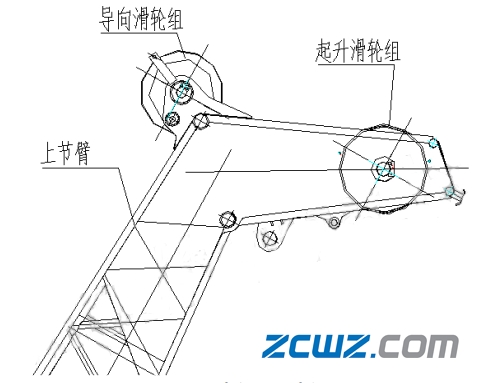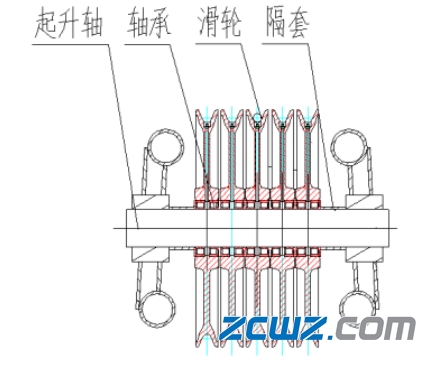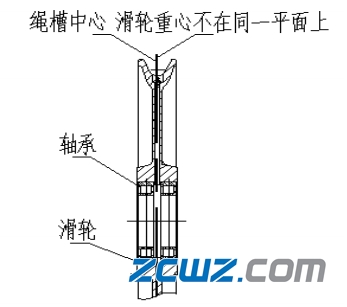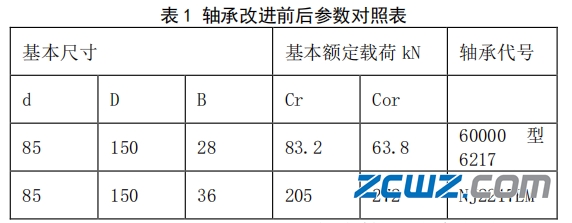The pulley block in the crane is an important part and an important part of the crane’s lifting. The pulley block is generally composed of rolling bearings, pulleys, pulley shafts, and rolling bearing spacers. The structure bears radial force better than axial force. In the use of this structure, the rolling bearing retaining ring, support ring, and spacer are often damaged, causing the pulley to be unable to rotate, and the wire rope is severely worn, so that normal construction cannot be performed.
Figures 1 and 2 above are respectively the top structure diagram of the crane and the specific installation structure diagram of the lifting pulley. The rolling bearing is installed in the pulley, and the pulley is installed on the upper arm by the lifting shaft, and a spacer is used between the pulley and the pulley to keep a proper gap to ensure that they do not interfere with each other during work. If the bearing is damaged, it will directly affect the normal lifting of the crane. Therefore, the following China Bearing Network (abbreviated as: China Shaft Network) shares common causes of crane pulley bearing damage and related improvement measures:
Analysis on the Causes of Crane Pulley Bearing Damage
1. Crane overload
The crane has a load table, that is, the crane must lift heavy objects in accordance with the load marked on the load table during construction, and it is strictly forbidden to perform construction beyond the data limited by the load table. The crane is designed with a safety factor, but the current domestic crane construction is generally overloaded, which causes the reserved safety factor to be relatively small, and even offsets the reserved safety factor. In this way, the partial mechanism of the crane may be damaged and malfunction, and the lifting weight is overloaded, which directly causes the bearing force on the lifting pulley part to increase, which is close to or exceeds the force range, which is the most direct cause of bearing damage.
2. Quality problems of pulleys
The hoisting pulley of the crane is directly wound with a wire rope, and the wire rope bears all the weight of the hoisted object, so the weight of the object is directly transmitted to the bearing through the wire rope and the pulley. The lifting pulley group is composed of a pulley and two bearings. The two bearings are installed on the left and right sides of the lifting pulley. If the center of the rope groove of the pulley and the center of the pulley itself are not on the same plane, see Figure 3 for pulley analysis. Gravity will not be evenly distributed on the two bearings, one large and one small, and even the gravity on a single pulley is completely borne by one bearing, and the bearing bears a large axial force at this time. Because the structure of the bearing determines that its ability to withstand radial force is much greater than its ability to withstand axial force, the bearing retainer ring is easily damaged under the action of axial force, and the bearing ball support frame is damaged, resulting in The bearings cannot rotate, the wire ropes and pulleys are worn out, and eventually the crane cannot work normally.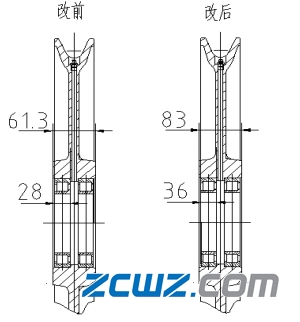
3. During crane construction, heavy objects are unstable in the air and there is shaking
The existence of shaking will also cause uneven force on the bearing. If the pulley is still rotating at this time, the bearing retaining ring will be significantly increased. In this case, the bearing retaining ring is easily damaged, causing the balls to move around. Furthermore, the bearing retaining ring is completely damaged, and the entire bearing is eventually damaged, affecting construction.
4. During the crane design process
When designing pulleys and selecting bearings, safety factors must be considered and reserved according to the load and construction conditions. If the safety factor is too small or the calculated load error is large, the weight calculation of a single pulley will be too small, which will cause the selection of the bearing to be inappropriate, and the bearing capacity cannot meet the actual work needs. In addition, if you are not familiar with the working conditions, only consider the static load and not the impact load, which will also cause the selected bearing to not meet the actual work needs, resulting in easy damage to the bearing and short life. If a bearing with a small parameter is selected, the bearing will be damaged prematurely even if there is no overload, unqualified pulley quality, and unstable lifting of heavy objects.
improvement measures
Construction machinery construction generally emphasizes timeliness, and time is benefit. As a special mechanical equipment, cranes must be analyzed for the above conditions to solve the problem of premature damage in order to continue the construction process (and uninterrupted). After analysis, I made some improvements to the structure of the crane’s lifting part.
1. Add overload limiting device: Calculate the maximum bearing capacity of the bearing according to the load table. When the bearing load is equal to the rated force, an alarm will be issued to remind the operator. When the bearing load force exceeds the rated load or exceeds the safety factor, the crane action is locked under the action of the safety device, forcing the construction personnel to construct according to the crane load table, thereby reducing the force on the bearing, protecting the bearing and extending the use of the bearing The role of life.
2. Change the structure of the pulley, increase the thickness of the pulley, and replace the bearing: the structure size and thickness of the pulley before the improvement is 61.5mm, and the matching bearing model is GB/T276-19946217-Z. The bearing width is 28, the improved pulley size is 83mm thick, the matching bearing model is GB/T283-19942217EM, and the bearing width is 36.
GB/T276-19946217-Z deep groove ball bearing basic load rating Cr=83.2kN, Cor=63.8kN. GB/T283-19942217EM reinforced cylindrical roller bearing basic load rating Cr=205kN, Cor=272kN. It can be seen from the table that the basic dynamic load and static load have been greatly improved. The change of the bearing from deep groove ball to cylindrical roller type and the increase of the thickness B of the pulley have greatly improved the axial force that the bearing can withstand. In addition, the NJ2217EM reinforced bearing has a solid brass cage inside, so the retaining ring is not easily damaged. After the improvement, the actual application verifies that the service life of the bearing is significantly extended.
3. Strictly control the quality of the pulley: improve the production process of the pulley and strictly control the inspection procedure of the pulley in the factory, and control the flatness of the pulley groove center and the pulley center to meet the design requirements to prevent the bearing damage caused by the pulley.
4. Without affecting the construction efficiency, increase the pulley block: increasing the pulley block at the upper end can increase the pulley ratio, thereby reducing the force on a single pulley and bearing. Due to the reduced force, the safety factor of the bearing can be improved, the probability of damage can be reduced, and the service life can be increased.
5. Train users to construct in accordance with the requirements of the equipment manual. Overloading is strictly prohibited. The weight should be kept stable during the lifting and lowering process of the weight to avoid the uneven force of the bearing caused by the shaking of the weight and the increase of axial force and damage. After the improvement of the above measures, bearing damage in practical applications is basically eliminated. It is proved that it is feasible to change the structure of the pulley, replace the bearing model, and increase the overload limiting device.
Post time: Jul-02-2021
